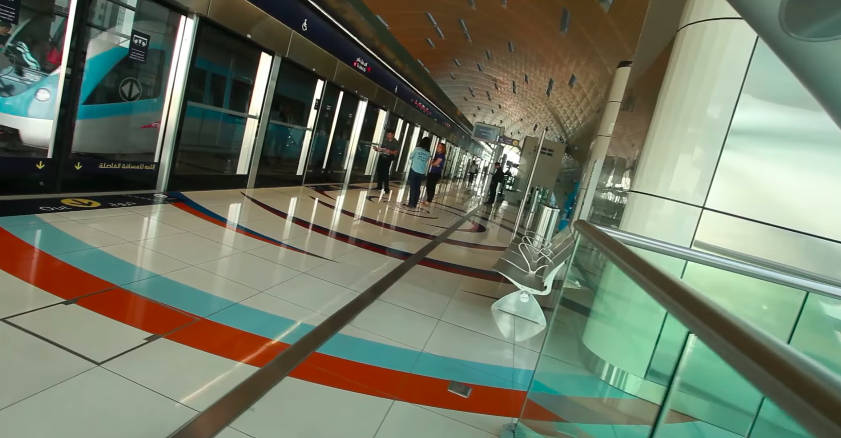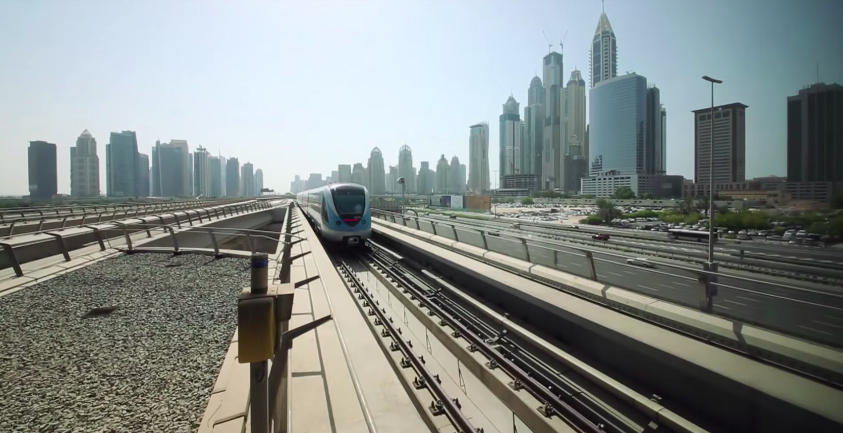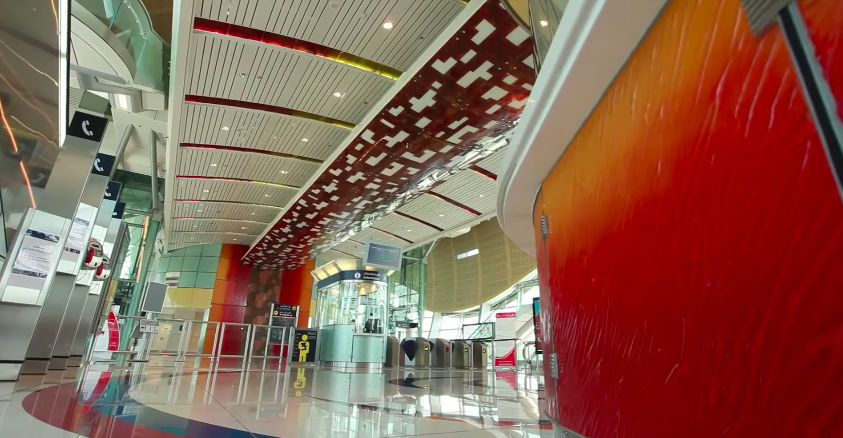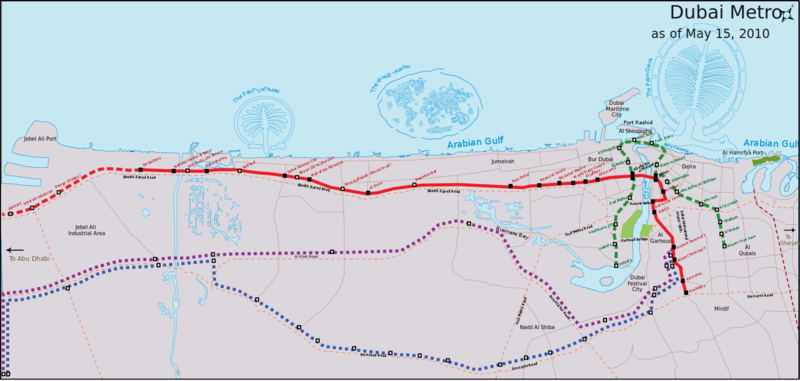The Dubai Metro is the metro service in Dubai, United Arab Emirates. It is owned by RTA and operated by Serco Group. The metro was inaugurated on September 9, 2009. It has 49 stations and two lines: the red line and the green line. It makes connections with buses, the Water Bus and trams. The metro goes directly to Dubai International Airport to terminals 1 and 3. It opens every day at 6:00 am, except on Fridays, in which it opens at 1:00 pm. You can buy tickets for as low as two AED (less than a US dollar). Only MasterCard and Visa credit cards are accepted to buy the tickets and cards for the metro. There are separate wagons for men and for women. As a fun fact, most stations are shaped like seashells. Four new lines are planned: blue, purple, pink, and gold. You can visit the Burj Khalifa by travelling 23 minutes in the metro.
Metros in the United Arab Emirates: The Dubai Metro
Dubai is the capital of the Emirate of Dubai in the United Arab Emirates. With a population of over two million people, it is the most populated city of the country. Dubai will host the Expo 2020 fair. The most important economic activity in Dubai is tourism. The city's infrastructure is impressive due to its size and futuristic design. It has some of the tallest buildings in the world. Tourists can enjoy shopping, fine cuisine, nightlife, among other activities.
The city has problems of high traffic, therefore, public transportation is recommended. The streets in Dubai are divided into five: E311, E77, E11, E44, and E66. Dubai has three airports: Dubai International Airport, which is the biggest airport, Sharjah International Airport and Al Maktown International Airport. The public transportation system in Dubai consists of buses, the Water Bus, the monorail, the tram and the Dubai Metro. The public transportation is owned by Road and Transport Authority (RTA). The metro is operated by Serco Group.
The Dubai Metro is one of the most advanced transportation systems in the world, and the first urban rail of the Arabian peninsula. It is a network with driverless trains (Thales Operating System) with air-conditioned stations and special cars reserved for women and children and passengers of the Gold Class.
Currently there are 75 kilometers of network fully automated (driverless) so it has been recognized in the Guinness Book of Records as the world's longest metro in this category.
History
The government of Dubai wanted to build a metro, along other urban projects, to attract tourists to the city. Also, the construction of the metro was done to solve the problem of high traffic in Dubai. The plan to build the metro was approved in May 2005. Among the companies involved in the construction of the metro were Mitsubishi, Systra, Yapi Merkezi, Obayashi Corporation and Parsons Corporation. The original contract stated that the red line would open in 2009, while the green line would open in 2010. However, the contract was updated to add extra stations to both lines, delaying the inauguration of the green line.
The construction of the red line began on August 2005, while the construction of the green line began on July 2006. The Dubai Metro was inaugurated on September 9th, 2009, with the opening of 10 stations for the red line. The red line was expanded to have 18 more stations on April 2010. Another station was inaugurated for the red line on September 2013. The green line was inaugurated on September 9th, 2011, with the opening of 18 stations. Later, two more stations were inaugurated for the green line on March 1st, 2014.
Lines and stations
The Dubai Metro has two lines: the red line and the green line. The metro has a total of 49 stations. The stations for each line are the following:
- Red Line: Goes between Al Rashidiya and UAE Exchange. It has the following 29 stations: Rashidiya, Airport Terminal 1, Airport Terminal 3, Emirates, Deira City Centre, GGICO, Union, Al Rigga, ADCB, BurJuman, World Trade Center, Al Jaffliya, Financial Centre, Emirates Tower, Business Bay, Burj Khalifa/Dubai Mall, First Gulf Bank, Noor Bank, Mall of the Emirates, Dubai Internet City, Sharaf DG, DAMAC Properties, Nakheel, Nakheel Harbour & Tower, Jumeirah Lakes Tower, Energy, Ibn Battuta (Dubai Marina), Danube, UAE Exchange.
- Green Line: This line offers rides between the regions of Etisalat and Dubai Creek. It has the following 20 stations: Etisalat, Dubai Airport Free Zone, Al Qusais, Stadium (Dubai), Al Nahda, Abu Hail, Al Qiyadah, Abu Bakr Seddiq, Union, Salahuddin, Palm Deira, Baniyas Square, Al Ghubaiba, Al Ras, BurJuman, Al Fahidi, Al Jadaf, Healthcare City, Oud Metha, Creek
Both lines, the Red Line and the Green Line intersect twice, in Union Square and Khalid Bin Al Waleed (BurJuman Centre)
Connections to other transportation services
The metro makes connections to other transportation services also owned by RTA. This includes the bus, the Water Bus and the tram. You can make the connections with the Nol Card, which automatically calculates and deducts the fare of the trip. You do not have to pay again when you board another vehicle. You can transfer to the tram in Jumeirah Lakes Tower metro station in the red line. You can switch between the red line and the green line at BurJuman and at Union metro stations.
Connection to airport
The metro goes directly to the Dubai International Airport. There are metro stations going to terminals 1 and 3 from the airport, which are Airport Terminal 1 station and Airport Terminal 3 station. To go to terminal 2 by using the metro, go to either Stadium station or Dubai Airport Free Zone station. From there, take a taxi towards terminal 2. The metro can also take you close to the Sharjah International Airport. You only need to board the metro towards Rashidiya station, and then walk to the airport.
The subway is the cheapest way to travel from the airport to the different zones of Dubai but is useful only if your hotel is near a metro stop, otherwise you have to keep in mind that some areas are not comfortable for walking.
On the other hand there are also 4 public bus routes leaving the airport and stopping at different places in Dubai. The prices are just AED2. The lines are: 401 (Deira) and 402 (Bur Dubai) with a frequency of 30 minutes, and C1 (Satwa Station) and C2 (Zabeel Park) pass every 10 minutes. C1 and C2 lines operate 24 hours a day, while the 401 and 402 operate to 22:00 p.m.
Finally in the arrivals area can hire taxis and limousines, any time of the day, paying in advance. The journey time to the city is about 10 minutes.
Schedule, timetables, and calendar
The metro is open every day, all year round. From Sunday to Wednesday, the stations open at 6:00 am and close at midnight. On Thursdays, the stations open at 6:00 am and close at 1:00 am. Finally, on Fridays, the stations open at 1:00 pm and close at midnight. During peak hours, the waiting time between trains is two minutes. During the rest of the day, the waiting time between trains is four minutes. In the red line, it takes one hour and 10 minutes to travel across all of its stations. In the green line, it takes 38 minutes to travel across all of this line's stations.
Prices, tickets, and cards
The metro's fare is paid with either the Nol card or with tickets. The difference between them is that the Nol Card is more advantageous if you are a frequent traveler and travel combining different means of transport. An additional advantage of the Nol cards is that they have a daily limit of AED14.00, so will not be charged more than AED 14.00 per day, no matter how much you use the transport and also will save the queues. But for the occasional traveler is not much difference from the normal ticket cost. There are transportation prepaid cards that can be recharged with a balance of AED and use it to travel on public transport in Dubai: bus, ferry, taxi. Rates vary depending on the number of zones, but generally for cards, fares start at AED 1.8 for a short trip (less than 3 km) to AED 5.80 for a journey through all areas.
They can be purchased at the box office and ticket machines at each station.
The prices will be shown in AED (United Arab Emirates Dirhams. 1 US dollar = 3.67 AED as of 03/20/17). The Nol card lets you use the metro and many other services owned by RTA. You cannot board the metro by paying the fare with cash. Discounts are available for people with disabilities, students, and senior citizens. There are also special subscriptions that offer discounts. These subscriptions are the following: 1 Day Pass, 7 Day Pass, 30 Day Pass, 90 Day Pass, and 365 Day Pass. Children of 0.9 meters in height and under five years of age can travel for free without requiring a ticket nor a card.

There are three available cards: Silver Card, Gold Card, and Blue Card. The tickets are called Red Tickets. All cards can be used for paying the parking services. The prices for the cards and the tickets are the following:
- 1) Silver Card (25 AED): Card in which you can load a maximum of 5000 AED in cash. This card can be bought at any office that sells tickets, as well as in ticket vending machines, at shops authorized by RTA (like newsstands,) and customer service offices. This card allows you to use the metro and all the other means of transportation of RTA. Works for five years. This card can be used as soon as you purchase it. It will come with 19 AED stored on it to use it for rides. The prices for rides to different zones are the following: one zone = 3 AED, two zones = 5 AED, and three or more zones = 7.5 AED.
- 2) Gold Card (25 AED): Similar to the Silver Card, but with the extra benefit of granting you access to first class seats without needing to pay a premium fee. This card is only sold at ticket offices from the metro. Works for five years. This card can be used as soon as you buy it. It works in all means of transportation of RTA. The Gold Card will have 19 AED stored on it to pay for rides. You do not require any documents to get this card. The prices for rides to different zones are the following: one zone = 6 AED, two zones = 10 AED, and three or more zones = 15 AED.
- 3) Blue Card (70 AED): Also known as personal card. When you first buy it, it will have 20 AED loaded on it for your trips. You can store up to 5000 AED on this card. This card has theft protection. If you lose this card or if it gets stolen, you will keep the cash that was loaded into your card. Every time that you use this card, you will get a SMS and an email. This card is valid in all means of transportation of RTA. It works for five years. The Blue Card offers discounts to the elderly, students, and people with disabilities. Students, senior citizens, and people on welfare get a 50% discount on rides. It needs to be activated at any customer support office. You require your ID and your photo to get it. If you want the discount for people with disabilities, you also need to present a card issued by the government proving that you have disabilities. People with disabilities travel for free. If you want the discount for students, you need to have a certificate from your school stating your student ID, name, the academic year you are in, and your highest level of education achieved. Also, you require to be between five and 23 years old. If you want the discount for senior citizens, you only require your ID. Only senior citizens with the United Arab Emirates citizenship or permanently living in the country can get this discount. This card allows you to store the following passes: 1 Day Pass, 7 Day Pass, 90 Day Pass, and 365 Day Pass. The prices by zone are the following: one zone = 3 AED, two zones = 5 AED, and three or more zones = 7.5 AED. You can get custom designs for your card, at a cost of 30 AED.
- 4) Red Ticket (2 AED): This is the only ticket available for the metro. They are sold at vending machines and at RTA offices. The ticket also works on the bus and the Water Bus, but does not offer transfers. You can get up to 10 rides with a bundle of 10 tickets. Valid for up to 90 days if you do not spend all of your tickets. The prices by zones are the following: one zone = 2 AED, two zones = 6 AED, and three or more zones = 8.5 AED.
More info: dubaicityinfo.com
Tips in the metro
- 1) Bring a MasterCard or a Visa credit card, since these are the only cards accepted for buying the tickets for the metro and the Nol Card.
- 2) All stations are named after the closest available landmark. For instance, Dubai Mall station is close to Dubai Mall. If you already know which landmark to visit, then go to the metro station named after it.
- 3) You cannot bring your bicycle to the metro. Therefore, make sure to know where to leave your bicycle if you are planning to ride the metro.
- 4) There is no driver cabin since the metro is automatic. Therefore, go to the front window of the wagon to get a beautiful view of the city.

Rules in Metro Dubai
Violating any rules will result in fines ranging from 100 AED to 2000 AED. The metro's rules are the following:
- 1) Nol cards are non-transferable. Therefore, do not use someone else's card.
- 2) Be respectful towards the other passengers.
- 3) Do not smoke in either the metro nor in the stations.
- 4) Do not put your feet in other people's seats.
- 5) Do not sell any goods in the metro nor in the stations. You cannot advertise either.
- 6) Entering the metro without a card nor a ticket is a serious offence. This would result in a 200 AED fine.
- 7) Do not destroy nor damage the seats or any other equipment from the metro. Do not cause damage to the stations either. This would result in a 500 AED fine.
- 8) Do not drink nor eat inside the metro. Chewing gum and drinking water is also prohibited. You are only allowed to eat and drink at stations.
- 9) Animals are not allowed on either the metro nor at stations. The only exceptions are guide dogs.
- 10) Do not enter staff-only areas at stations.
- 11) Do not litter or spit in the metro nor at stations.
- 12) Do not use emergency exits or emergency-only equipment outside of an emergency. This would result in a 2000 AED fine.
- 13) The metro's wagons are divided into men-only wagons and women-only wagons. If you are a male, do not enter the wagon for females, and vice versa.
- 14) Do not sit on first class seats if you do not own a Gold Card.
- 15) Do not try to force open the trains' doors.
- 16) Do not bring alcohol to either the metro nor at stations.
- 17) Parking services are offered only for one day. Using a parking spot for more than a day will result in a 100 AED fine. Overstaying in that parking spot for over 48 hours will result in a 240 AED fine.
- 18) Do not use counterfeit tickets nor cards, or you would get a 500 AED fine.
- 19) Do not sleep at the metro's stations, or you would get a 300 AED fine.
- 20) Do not climb into the metro. This would result in a 100 AED fine.
- 21) Only use the spots reserved for pregnant women, people with disabilities or senior citizens if you belong to those categories. Otherwise, you would get a 100 AED fine.
- 22) Obey RTA's staff orders, or you may get a 100 AED fine.
- 23) Only sit or stand at areas allowed for passengers.
- 24) Weapons and hazardous materials are not allowed in either the metro nor at stations.
- 25) You require RTA's permission if you want to sell Nol cards.
- 26) Be sure not to board the metro with an expired ticket or card. Show your card or ticket if an inspector asks you to do it.
- 27) It is not allowed to bring fish to the metro.
Fun facts
- 1) All trains have air conditioning.
- 2) For security purposes, there are doors that separate the platforms from the metro's tracks.
- 3) You can see breathtaking views while travelling in the metro since the tracks are elevated.
- 4) The stations' architecture combines elements that are both old-fashioned and modern. They have new elements because the stations look futuristic from the outside. And they have old elements because the inside of the stations have traditional Arabic architectural elements such as internal arches and wind towers.
- 5) Most stations are seashell-shaped.
- 6) The BurJuman station has chandeliers that are shaped like a jellyfish.
The Dubai Metro is considered the "world's safest metro", with its own police force, over 3000 CCTV on trains and stations to monitor security violations, integrated radio system between underground services and emergency services, emergency telephone in each car and station and platform screen doors.
Another of its curiosities, as there can be less in the city of luxury and ostentation is the existence of a Gold Wagon that provides a first class service with leather seats, panoramic views, carpeted floors and exclusive lighting and design. There is also a carriage reserved for women and children while is not mandatory for women to travel separately. Finally, there is wi-fi and telephone coverage throughout the metro network.
Future expansions
Four new lines are proposed to be built. These lines are the blue line, the purple line, the gold line, and the pink line. The construction of the purple line and the blue line are still in discussion, but may begin in 2017. The blue line will have stations across Mohammed Bin Zayed Road. The purple line is planned to have stations across Al Khail's Road. This line will have 8 stations, and will have 50 kilometers of railway. The purple line will offer rides between the Al Maktoum International Airport and the Dubai International Airport. The pink line is planned to be built by 2030. It will have stations in the region of Al Sufouh. The gold line is planned to be built by 2025. This line will have stations in Deira, Dubai Marina, and Arabian Ranches.
The government in Dubai also plans to expand the green and red lines. The green line will have 12 new stations, along with 20 kilometers of extra railway. This expansion is planned to be finished by 2020. The new stations for the green line will go from Al Jadaf to the regions of Academic City, Silicon Oasis, Festival City, Ras Al Khor Industrial Area, Lagoons, and International City. The government plans to build six more stations for the red line, along with 16 kilometers of extra railway. The red line's expansion will offer rides to the regions of Abu Dhabi and Al Warqa'a.

Nearby attractions
The Airport Terminal 1 station for the metro's red line will be used as a reference point. To go to touristic attractions using the metro from Airport Terminal 1 station, follow these instructions:
- 1) Dubai Museum: The whole trip costs five AED, and lasts 28 minutes. From Airport Terminal 1 Station 1, board the metro in the red line towards UAE Exchange station for 12 minutes. Get off at BurJuman station 1. Next, walk 7 minutes to Four Point Sheraton Hotel 02. Board bus C05 towards Ghubaiba Bus station for two minutes. Get off at Al Fahidi Metro Bus Stop A 02. Finally, walk to Al-Fahidi Street, Al-Fahidi.
- 2) Burj Khalifa: The whole trip costs five AED, and lasts 23 minutes. From Airport Terminal 1 Station 1, board the metro in the red line towards UAE Exchange Station for 23 minutes. Finally, get off at Burj Khalifa/Dubai Mall Metro Station 1.
- 3) Sheikh Saeed Al-Maktoum House: The whole trip costs five AED, and lasts 40 minutes. From Airport Terminal 1 Station 1, board the metro in the red line towards UAE Exchange station for 12 minutes. Get off at BurJuman Station 1. Next, walk 7 minutes to Four Point Sheraton Hotel 02. Board bus C05 towards Ghubaiba Bus station for five minutes. Get off at Falcon Intersection 02. Finally, walk 16 minutes to Al Khaleej Road, Bur Dubai.
- 4) Jumeirah Mosque: The whole trip costs 5 AED, and lasts 58 minutes. From Airport Terminal 1 Station 1, board the metro in the red line towards UAE Exchange station for five minutes. Get off at Deira City Centre Metro Station 1. Next, walk three minutes to City Centre Metro Bus Stop A 01. Board bus X28 towards Dubai Internet City Seaside Metro Bus Stop for 29 minutes. Get off at Dhiyafa 01. Walk 18 minutes to Jumeirah First, Jumeirah Mosque.
- 5) Bastakia: The whole trip costs five AED, and lasts 20 minutes. From Airport Terminal 1 Station 1 board the metro in the red line towards UAE Exchange station for 12 minutes. Get off at BurJuman Station 1. Next, walk three minutes to BurJuman Metro Station 02. Board the metro in the green line towards Etisalat station for two minutes. Get off at Al Fahidi Metro Station 2. Finally, walk towards Old Dubai in the Al-Fahidi Neighborhood.
Dubai metro map
- Passengers/Day
- Fares: gates
- 24h operation: No
- Air Conditioning: Yes
- Walk between platforms: Yes
- Driverless trains: Metro (since 2009)
- Screen Doors Platforms: Metro, monorail
- Operator: Serco/Roads & Transport Authority
- AED 1.80
- Dubai Metro Official Website
- Tlf: +971 4 284 4444
Help us
If you consider that the information we provide is wrong, not accurated, outdated, translation contains errors, and you would like to help us to improve the file...you can contact us here.
Feel free to contact us if you dont find the system you're looking for and we'll add it as soon as we can!
Thank you very much!











